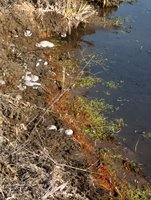Orange ooze gives clues for those in the know.
 If you walk your property with an eye to understanding how it works, knowing what orange ooze is and what it means is a worthy skill. Orange ooze forms where anaerobic waters seep from the ground. This can be a good and natural thing, as in the image.
If you walk your property with an eye to understanding how it works, knowing what orange ooze is and what it means is a worthy skill. Orange ooze forms where anaerobic waters seep from the ground. This can be a good and natural thing, as in the image.
Reduced iron (Fe(II)) is a source of energy for life, including iron-oxidizing bacteria. The oxidized iron gives orange ooze its distinctive color. Another distinctive feature of anaerobic waters is a surface sheen, reminiscent in appearance of an oil sheen, but brittle.
Anaerobic waters form for specific reasons.
Unfortunately, one reason is contamination. A classic source of Fe(II) laden waters are acidified drain waters associated with mining and industrial wastes. Other reasons are septic systems, waste water lagoons and land fill leachate. Fuel leaking from a transfer line is a classic source. Any substance that can be rapidly decomposed by microbial activity, even a benign dust control product like lignin sulfonate, can result in anaerobic groundwater if concentrated by runoff in a roadside ditch.
Anaerobic groundwater formation is usually natural. Examples are flows through wetland conditions (as in the image) and through pond bottoms. In natural cases, orange ooze relates to elevated microbial activity. This biological activity usually needs a temperature above 41 degrees F (5 decrees C) and an adequate food supply to support microbial respiration in excess of oxygen supplies.
Now look closely at the image. Notice the greenest vegetation is in the band of water with the anaerobic sheen, parallel, and below the orange ooze. That is because the seep water is warmer than the surface water it is flowing into, stimulating a difference in plant growth. The elevation of the orange ooze shows the anaerobic water is dropping into the stream. Not shown is that it is on only one side of the stream and only along a limited stretch. This gives important clues as to where to look for the source, in this case wetland conditions in the pasture adjoining the stream. The warmth of the seep indicates that the hydrology supporting wetland living conditions is not localized winter precipitation and snow melt, but has deeper, less seasonal, origins.
1 comment:
We have some orange and yellow ooze that came up in our yard in two places... any ideas what it is? See http://picasaweb.google.com/mark.chance/WhatIsThisFungus
Post a Comment